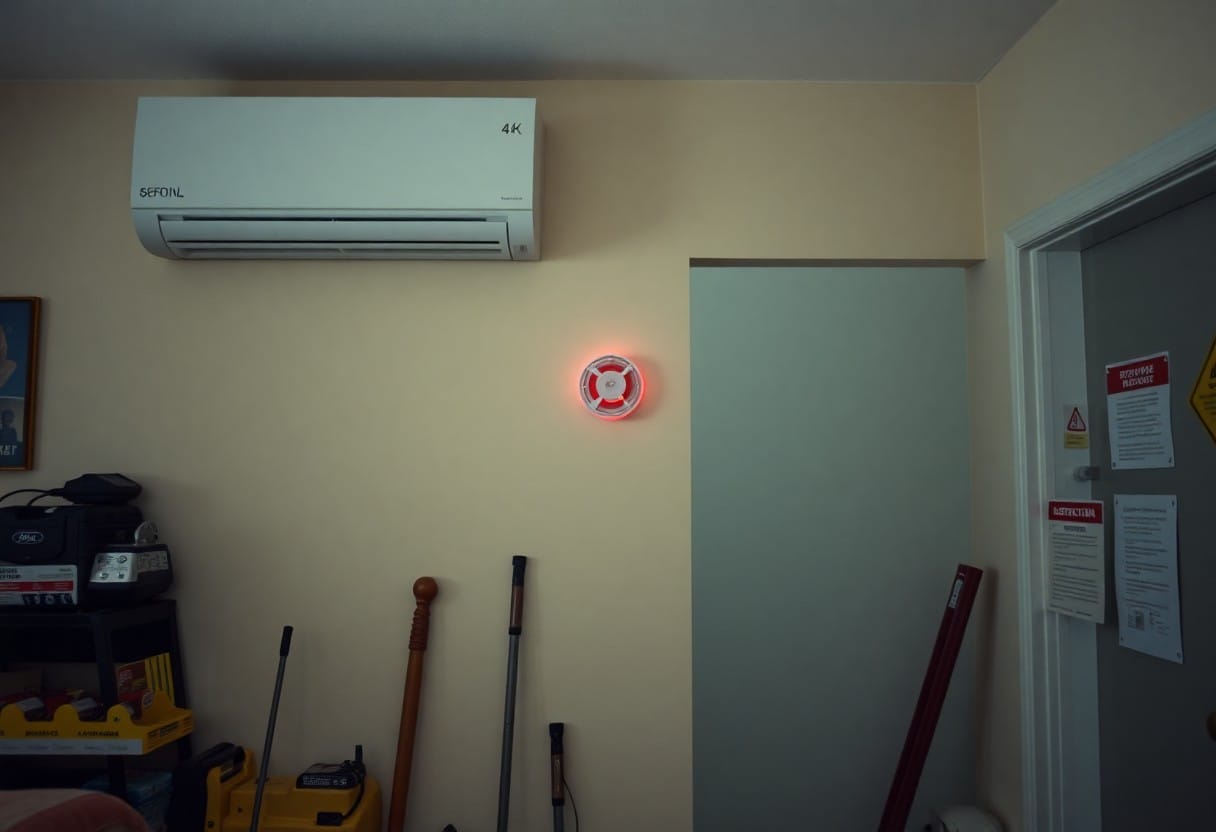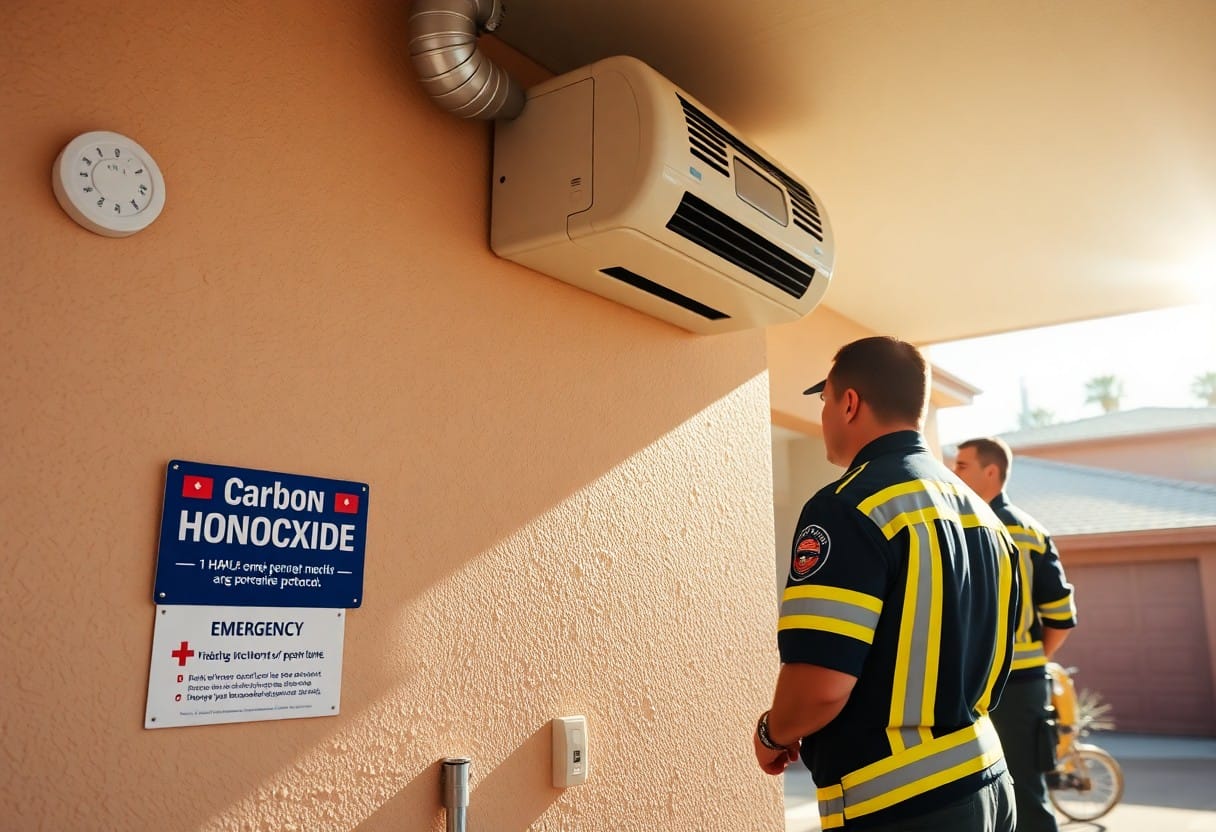Carbon monoxide is a silent yet lethal gas that can infiltrate your home through faulty HVAC systems. You must be aware of the symptoms of carbon monoxide poisoning, such as headache and dizziness, as they can escalate quickly into life-threatening situations. Installing carbon monoxide detectors and understanding how to respond can significantly enhance your home’s safety. This guide will equip you with the knowledge to identify and address a carbon monoxide emergency effectively, ensuring the well-being of you and your loved ones in your Phoenix home.

Understanding Carbon Monoxide
What is Carbon Monoxide?
Carbon monoxide (CO) is a colorless, odorless gas that can be produced during the incomplete combustion of fuels. It binds with hemoglobin in your blood more effectively than oxygen, which can lead to serious health risks. As a toxic substance, it poses significant dangers in enclosed spaces where ventilation is inadequate. Low levels of CO exposure may result in mild symptoms, while high levels can be lethal within minutes.
In your home, even small amounts of carbon monoxide can cause headaches, dizziness, confusion, and fatigue. Prolonged exposure can lead to severe damage to organs or even death. The risk factor increases dramatically when heating systems, appliances, and vehicles malfunction or are improperly used.
Sources of Carbon Monoxide in Homes
Common sources of carbon monoxide in your home include gas-fired appliances, such as furnaces, water heaters, and stoves. Any fuel-burning device can produce CO, providing there’s insufficient oxygen for complete combustion. Additional sources may include fireplaces, generators, and even attached garages where car exhaust can seep into living spaces.
Faulty ventilation systems can exacerbate the situation, trapping the gas indoors. Regular maintenance of your HVAC system is vital to ensure any potential CO leaks are detected and addressed promptly. If your home still uses older appliances, consider upgrading to newer, more efficient models that reduce CO emissions. Ensuring that flues and vents are clear and well-maintained is also vital to minimizing this deadly gas.
Be aware that even outdoor sources may impact indoor air quality. For instance, using a grill or oven indoors, or running a generator close to windows or doors, can lead to a dangerous buildup of carbon monoxide inside your home. Vigilance in recognizing these hazards is fundamental to ensuring your home’s safety.
Signs and Symptoms of CO Poisoning
Recognizing Early Symptoms
Your body can exhibit several signs when exposed to carbon monoxide (CO). Early symptoms commonly include headaches, dizziness, and weakness. These can be easily mistaken for a variety of other ailments, often leading you to dismiss them as simple fatigue or a mild flu. If your home experiences a sudden increase in these symptoms, especially if multiple occupants feel unwell, investigate the possibility of CO exposure.
Nausea and shortness of breath are other significant indicators. If you start feeling these symptoms in conjunction with the presence of fuel-burning appliances such as furnaces or water heaters, it’s vital to take immediate action. Opening windows, turning off appliances, and evacuating the space should be your top priorities.
Long-Term Health Effects
Prolonged exposure to carbon monoxide can manifest in severe, lasting health issues. Individuals may experience neurological damage, including cognitive deficits and memory loss. The extent of these effects often hinges on the duration and level of exposure, with some people sustaining long-term complications long after accounting for immediate symptoms.
Even low-level exposure can lead to chronic health problems. Individuals exposed to CO over an extended period may encounter ongoing symptoms such as persistent headaches, fatigue, and difficulty concentrating, which can severely impact daily functioning and quality of life. Studies suggest that even a few hours of exposure to elevated CO levels can result in irreversible damage to the brain and other organs.
HVAC Systems and Carbon Monoxide Risks
HVAC Equipment as Potential Sources
Your HVAC system can be a significant source of carbon monoxide if not properly maintained. Equipment like furnaces, boilers, and water heaters can produce CO during operation, especially when there’s a malfunction or blockage in venting systems. Inadequately ventilated gas appliances can lead to dangerous levels of CO circulating in your home.
Faulty burners, cracked heat exchangers, or blocked flues are common issues that can elevate CO levels. These defects may occur over time or after significant wear and tear. Regularly assessing your HVAC system can help identify these hazards and prevent potentially life-threatening situations.
Importance of Regular Maintenance
Scheduling regular maintenance checks for your HVAC system is a proactive approach to mitigating carbon monoxide risks. Trained technicians can pinpoint issues before they escalate, ensuring that all components are functioning correctly and efficiently. Routine inspections help maintain air quality and enhance your system’s lifespan by detecting problems such as gas leaks, which could lead to CO production.
Enlisting the services of a qualified HVAC professional not only affirms your system’s operational reliability but also safeguards your home against the hidden dangers of CO poisoning. A clean and well-tuned system reduces the chances of incomplete combustion and promotes safe ventilation practices, keeping your family safe year-round.
Detection Methods
Carbon Monoxide Detectors
Installing carbon monoxide detectors in your home is necessary for safety, especially in areas where fuel-burning appliances are present. These devices continuously monitor the air quality and sound an alarm if CO levels exceed safe thresholds. It’s advisable to place detectors in key areas, such as near sleeping quarters and within close proximity to potential sources of CO, like furnaces and water heaters. Regular testing and maintenance—including replacing batteries annually and checking the unit’s expiration date—help ensure that your detectors function effectively.
Top-rated models often include features like digital displays to indicate CO levels, voice alerts, and even smartphone connectivity. Consider investing in interconnected systems that trigger alarms throughout your home if one unit detects CO. This way, you and your family will be alerted promptly, no matter where you are indoors.
Signs of Malfunctioning HVAC Systems
Identifying signs of a malfunctioning HVAC system can prevent CO buildup and other hazardous situations. Common symptoms include inconsistent temperature regulation, unusual noises such as banging or hissing, and signs of moisture or rust around the unit, which could indicate leaks. Additionally, yellow or flickering pilot lights on gas appliances, instead of the typical blue flame, may suggest incomplete combustion and a potential risk of CO production.
Regular maintenance checks, including professional inspections, are vital to catching these indicators early. Be attentive to sudden increases in energy bills, as these can signify that your HVAC system is working harder than normal—often a precursor to failure and increased CO generation. If you notice these warning signals, consider scheduling a service call to ensure your system operates safely.

Emergency Response Protocol
Immediate Actions to Take
Upon detecting carbon monoxide in your home, evacuate all occupants immediately. Make sure to assist anyone who may have difficulty leaving, such as children, the elderly, or pets. Once you are outside, seek fresh air to minimize exposure. If you have a CO detector, ensure it is functioning properly and take note of any alert signals. Avoid using any ignition sources, like matches or lighters, as they could ignite an explosion.
After exiting the premises, stay a safe distance away and monitor your surroundings for symptoms of carbon monoxide poisoning, which include headache, dizziness, and nausea. The longer you stay in a CO-filled environment, the greater the risk of serious health effects or even death. Do not attempt to re-enter the home until it has been evaluated and deemed safe by professionals.
Calling for Professional Help
Contact emergency services or your local fire department immediately. They are equipped to handle carbon monoxide emergencies and can assess the situation effectively. Provide them with all relevant information, including your symptoms and the readings from your CO detector, if applicable. While waiting for help, ensure that emergency responders have clear access to your property.
Emergency services may perform air quality tests to confirm the presence of carbon monoxide and identify its source, whether it’s a faulty furnace or another appliance. Relying on trained professionals is necessary, as they have the tools and knowledge needed to address the issue safely and prevent further incidents.
Preventive Measures
Regular HVAC Inspections
Scheduling regular HVAC inspections can significantly reduce the risk of carbon monoxide leaks in your home. During these inspections, a qualified technician evaluates vital components of your heating system, including the furnace, venting systems, and gas lines. Detecting issues early can prevent dangerous CO buildup and ensure optimal performance of your HVAC system. Industry standards recommend at least one comprehensive inspection annually, ideally conducted just before the heating season.
Technicians will check for proper ventilation and air quality, as poor airflow can contribute to hazardous conditions.
Updating Safety Equipment
Outdated safety equipment can jeopardize your family’s safety from carbon monoxide hazards. Regularly updating smoke and CO detectors is necessary to guarantee their effectiveness; most detectors have a lifespan of around 5 to 7 years. Installing new detectors with digital displays or smart technology can enhance your monitoring capabilities, alerting you to CO presence before symptoms manifest. Position these detectors near sleeping areas and on every floor of your home for comprehensive safety.
Consider investing in home safety solutions that integrate with your existing HVAC systems, providing real-time data on air quality and carbon monoxide levels. These advanced systems can often be linked to your smartphone, offering you around-the-clock monitoring and alerts directly to your device.
Performing an annual check and replacing batteries in all detectors is an effective practice to maintain safety standards. Consider models that include voice alerts, which can distinguish between smoke and CO alarms, ensuring that you respond appropriately in each situation.
Conclusion
Taking this into account, ensuring your HVAC system is equipped with carbon monoxide detection devices is important for maintaining safety in your Phoenix home. Regular maintenance and timely inspections of your heating systems can prevent potential carbon monoxide leaks. You should always prioritize the installation of CO detectors in key areas, such as bedrooms and common living spaces, to enhance your protection against this silent threat.
In the event of a carbon monoxide alarm, immediate action is necessary. You must evacuate your home and contact emergency services for assistance. Your preparedness and quick response can make a significant difference in safety during an HVAC-related emergency. Taking these steps will not only safeguard your household but also provide peace of mind while using your heating systems during the cooler months in Phoenix.

